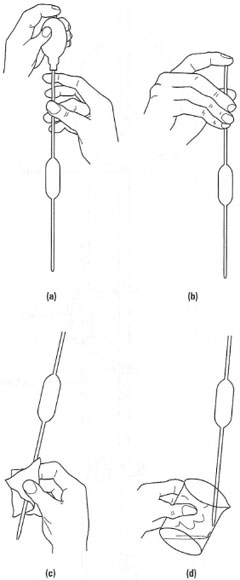Using a pipette
A clean 2S.00mL pipette is required together with a suitable pipette
filler. Various designs of pipette filler are available. The most common type is
based on a rubber-bulb suction device. It is best to evaluate a range of
pipette fillers, if available in the laboratory, for ease of use and performance.
The pipetting procedure is as follows:
- Pour the solution of unknown composition (the titrand) into a beaker.
Never place the pipette in the volumetric flask containing the solution as
this can lead to contamination of the solution from the external surface
of the pipette.
- Using your pipette filler, draw the titrand to just beyond the graduation
mark (Fig. 21.3a). Remove the pipette filler, and invert the pipette to
allow the solution to drain out. This ensures that the titrand used
subsequently will be undiluted and uncontaminated by any residue or
liquids in the pipette.
- Refill the pipette until the meniscus of the titrand is above the graduation
mark (Fig. 21.3a). Remove the pipette filler and block the hole at the top of
the pipette with the index finger of your right hand (if right-handed; Fig.
21.3b). Carefully raise the pipette to eye level, and allow the titrand to drain
out into a beaker by lifting your finger slightly from the top of the pipette.
Continue until the bottom of the meniscus is on the graduation mark.
- Wipe the outside of the pipette with a tissue (Fig. 2l.3c). Be careful not
to touch the point of the pipette with the tissue otherwise solution will be
lost by capillary action.
- Allow the pipette's contents to drain into a conical flask.
- Finally, touch the end of the pipette on the wall of the flask (Fig. 21.3d),
and rinse the inside of the neck of the flask with distilled water. This will
ensure that exactly 25.00 mL of the test solution has been delivered by the
pipette.
Note that it is normal for a small quantity of solution to remain in the
pipette tip. This volume is taken into account when pipettes are calibrated, so
do not attempt to 'blowout' this liquid into the conical flask.
 |
| Fig. 21.3 Using a pipette. |





